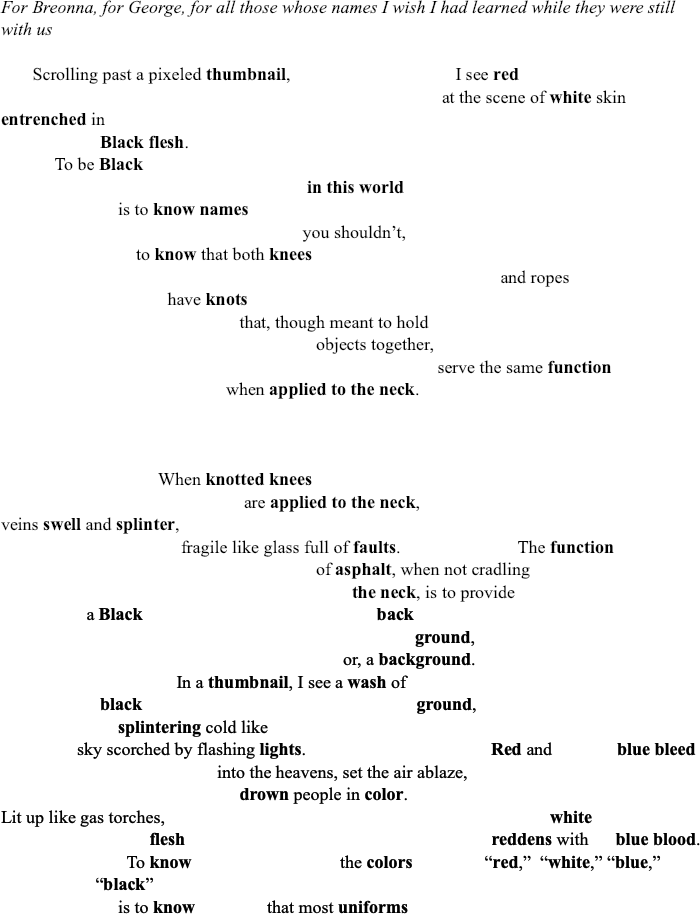Three Flash Essays on the Border
1. Fish Tacos in Tijuana
I am sitting in the front row of the red bus when the driver pulls the metal handle that folds the door open. The uniformed man working for U.S. Border Patrol stomps up the bus stairs holding a clipboard. He reminds me of the stocky men who were not coaches or parents or even athletic trainers, but always seemed to be hanging around at school football, basketball, and soccer games, jotting things down into clipboards. Almost belonging, but not quite.
As the Border Patrol agent stands near me, my mouth dries up and I have to remind myself to breathe. Every few seconds, I look down at my lap to check that my hand still holds my blue passport. I don’t believe it’s there; I have to keep checking.
If the Border Patrol agent asks me a question, I’m not sure that I could respond in a coherent English sentence, even though it’s the only language I can speak sentences in.
This man stands between me and my country. He can decide with a word that I can’t return. I look down at my passport again, but I would not be surprised if the blue cover dissolved into liquid and dripped from my fingers.
Until I am suddenly thrust underwater in this trauma response, I forget that this is what happens to me at international borders. I’ve had a lifetime of practice so I can mask my fear and appear calm, but I am practically phobic about crossing borders.
My parents brought me to America when I was a toddler with plans to return to the Philippines, but we stayed and overstayed, and I became an American who believed I had the right to be there until I found out the hard way that I didn’t. During the years that our papers were getting worked out, I learned to fear borders and the uniformed men who asked you questions and spoke to you in a way that made you feel that it was their country and you were intruding onto land that you didn’t deserve access to.
My then-boyfriend sits next to me on the bus. His family began their life in the United States on plantations in the South. He’s uncomfortable around uniformed men, police, for a different reason than me, but borders don’t scare him. Even though the photographs and records of his family stop a few generations back, he grew up hearing the stories of what his ancestors did to build the wealth that white Americans still enjoy. It’s never crossed his mind that he wouldn’t be allowed back in. They wouldn’t dare.
Our relationship to the United States is as different as our histories in it.
It was his idea that morning to drive a few hours south from our home in Los Angeles because he had a craving for fish tacos. Back then, it was nothing for us to wake up on a weekend morning and decide to drive to the border so that we could find that woman with the fish taco cart in Tijuana. She wasn’t always on the same sidewalk and her cart didn’t have a name so sometimes we would wander for an hour looking for her, walking past people trying to get our attention, men blowing whistles to entice us to enter their dance clubs, men carrying cameras inviting us to pose next to donkeys painted like zebras, and endless shops selling discount souvenirs and discount pharmaceuticals. This was a lot of effort for fish tacos, especially considering we lived in LA where taco stands were as common as Dunkin Donuts are where we live currently in New England, but even now, years later, I remember how happy we were when we would find the woman, as if we were reunited with a long-lost aunt, how we’d watch her drop the fish into the bubbling oil, how the liquid batter solidified into a golden crunch, how our eyes would glisten after taking the first bite.
The Border Patrol agent is cranky. Throughout his shift, he has been barking instructions at busloads of tourists, college kids, and day drinkers, including this red bus whose route crosses the U.S.-Mexico border from Tijuana to San Ysidro, back and forth, over and over.
“You are not citizens of California,” he says. “Do you understand? California is not a country.”
When I’m in the middle of a moment like this, everything leaves my head and it’s difficult to think clearly. Is this a trick? I turn to my boyfriend. “What am I supposed to say?” I whisper. “Because I do live in California.”
He thinks the Border Patrol agent is funny, a kind of comedian trying to make the best of a repetitive job. He’s surprised when he sees my face, how distressed I seem. After all, I am in no danger, but this is the thing about traumatic experiences, the sound they make can echo for a lifetime. Before I was naturalized as a U.S. citizen, I lived in fear that one encounter with the wrong person would kick off a series of events that ended with me deported. Even today, a part of me still fears this, especially considering this administration’s racist attacks on immigration. In 2018, U.S. Citizenship and Information Services removed the phrase “a nation of immigrants” from its mission statement. That same year, a task force on denaturalization was created to focus on ways to revoke citizenship from those who had naturalized the way that I had. Even though I know the point of all these anti-immigrant policies is to create an unwelcoming environment and intensify immigrants’ feelings of insecurity, it’s difficult not to react instinctively with fear.
But trauma doesn’t recognize time. That day, I am sitting on a red bus over the U.S.-Mexico border next to the man who will eventually become my husband. He is Black American and I am an immigrant from the Philippines, formerly undocumented.
“What am I supposed to say?”
“The answer is you are a U.S. citizen,” he says.
“You are a U.S. citizen,” I repeat.
“No,” he says. “Answer, ‘I am a U.S. citizen.’”
I nod, repeating, “I am a U.S. citizen,” in my head until it’s my turn to face the Border Patrol agent.
After all that anxiety, the Border Patrol agent barely glances at me and the flash of blue paper in my hand. This time I am lucky. He’s not interested in someone who looks like me.
2. Lubbock, Texas
I am riding in the front seat of the rental van after my uncle’s funeral. The caravan of mourners is so long that I can’t see his hearse. People seem different in Texas. No one has to ask, but once they see us coming, vehicles pull over and stop until all of us pass. I feel their sympathy and condolences. They are not in such a hurry. Drivers in Boston beep impatiently if you don’t immediately move when the light blinks green. The drivers in Texas watch our procession pass them and this acknowledgement feels respectful. They are recognizing that a person has died and crossed the final border into eternity.
A person, who was once alive and driving on these very roads, has died. Stop your car.
For years, every time I saw my father’s oldest brother at a family wedding or event, he invited me to visit him in Lubbock. He wanted to show off his ranch. I always meant to go, but I never seemed to have enough time or money to make the trip. When I found out that he died, I did not hesitate to purchase the last-minute airline tickets at four times the usual price, even though I had waited too long for him to know that I had finally accepted his invitation.
In the 1970s, my uncle had appeared as the on-air physician on the weekly Philippine TV show, Kapwa Ko, Mahal Ko, translated to “My Brother’s Keeper,” a program broadcast on the GMA network which shared the stories of patients needing medical and financial help. After four decades, the show still airs, a sort of early version of the now ubiquitous crowdsourcing campaigns where even employed Americans must plead for help to cover expenses when faced with unexpected catastrophe. When I introduced myself to other Filipinos, sometimes they heard my last name and asked if I was related to the kind doctor from TV. It was a jarring experience, name recognition, after a lifetime of feeling so foreign.
Although we are in Texas, this is a Filipino funeral. The wake, the speeches, the Catholic funeral Mass, all of it is live-streamed so that loved ones in the Philippines and all around the world, can attend.
At the gravesite, I stand around the rectangle of earth with fellow mourners and stare at his headstone, the shiny slab already cut with our last name. It is shocking to read my last name on a tombstone. We are still new enough in this country that I haven’t ever seen my name etched so coldly and permanently on polished stone. My extended family in the Philippines regularly visits the cemeteries where our dead lie, especially on All Souls’ Day. But even though we have been in America for decades, we are still too new in this country to have many gravesites to clean.
Does one belong more to the country where one is born or the country where one is buried? I belong to both places and neither. I was conceived in a place that my family left when I was two years old. We cut ourselves from our family tree, grafting this new branch onto a different tree in America. The life that I would have lived back there ended, and a new life here bloomed. But decades later, the transplant didn’t bear fruit: I don’t have any children to clean my future gravesite during All Soul’s Day. Even though I am the one who asked this question, I cannot answer it. Perhaps the question of burial is moot; I would rather be cremated. As it is, I’ve rarely ever felt as though I belonged to a particular place; I’ve only ever belonged to people; to those who I love.
3. Brown Paper Packages
During these pandemic times in America that stretch on and on, I think about how I used to react with pity when I heard about how funerals in the Philippines have been live-streamed for years, a way to include mourners such as the many Overseas Filipino Workers who can’t come home at a moment’s notice. How sad, I used to think, to have to mourn through a screen. I was reminded at those times how lucky I was to be American.
Besides teaching, meeting, working, and socializing online, like everyone else around me, I’ve celebrated several family birthdays, a bar mitzvah, my nephew’s high school graduation, and other milestones on Zoom. I even crashed the wedding of a friend’s friend; while she and I were on Facetime, she held her phone up to her laptop and we watched her friends exchange vows on Zoom.
My loved ones in the Philippines are not quite back to a virus-free life because there is no vaccine yet, but posts of their daily lives indicate a much wider range of activity than mine. As we get closer to All Soul’s Day, my relatives post photos of themselves at the gravesites of my grandparents, aunts, and uncles, and then at a long table sharing a meal together in a restaurant. What photos would I post? An image of my screen looking into someone else’s screen? Who is pitying who now?
During our first few years in America away from our extended family, these technologies did not exist. Instead, a few times a year, packages arrived from the Philippines with news of our clan. I remember the rough paper of the packages, the canceled stamps, the flowery handwriting–how foreign the package seemed as we sat around it at the kitchen table in Boston, my father carefully slicing through the layers of brittle brown tape.
Inside there were grainy photos about the size and shape of my iPhone of my aunt Baby, in white, by then well past childbearing age, feeding wedding cake to her husband; my godmother Lydia, smiling with anguish next to her husband’s open casket; school pictures of my parents’ godchildren with their names and ages scrawled on the back. There were cassette tapes, letters written in sound, but by then, I could no longer understand Tagalog, and I did not smile the way my parents did when they heard the voices of their parents and siblings.
I had lived with these relatives in our family compound back in the Philippines since the day I was born, but I didn’t recognize their names or voices. They were strangers to me now, separated not only by land and ocean, but by language.
My father did not plan on us staying long in America. We were supposed to return and be reunited with everyone in the family compound. Being the resourceful immigrant that he was, he reused the cassettes, taping over the familiar voices with music from his vinyl record albums that he wanted to listen to in the car. Why buy new when you can recycle used?
Until I was in the copyediting process for my memoir, I didn’t know the difference between “emigrant” and “immigrant.” Merriam-Webster’s Usage Notes explains that the terms are practically the same, but with one slight difference: “immigrant is used in reference to the country moved to, and emigrant is used in reference to the country moved from.” We were emigrants with an “e” when we left the Philippines, and we became immigrants with an “i” (and an additional “m”) when we arrived in the US. Merriam-Webster continues by explaining that even the verb forms of these words are used interchangeably, “the borders between these words are somewhat porous.” I never considered that even words had borders, but I suppose almost everything that we’ve imagined into existence, like race, must prove it can withstand defining.
My father didn’t know that we wouldn’t go home to the Philippines for almost two decades. We could not risk crossing borders until our immigration status was fixed. By then, many of the people on those cassette tapes were dead, the sound of their voices overwritten with The Carpenters, John Denver, and The Jackson Five. The stories from the Philippines that were once important enough to record and mail to us in America were covered over, the way green grass grows over a grave.

Grace Talusan‘s memoir, The Body Papers, is a New York Times Editors’ Choice selection, a winner in nonfiction for the Massachusetts Book Awards, and winner of the Restless Books Prize for New Immigrant Writing. Her short story, “The Book of Life and Death“, was chosen for the 2020 Boston Book Festival’s One City One Story program and was translated into several languages, including Tagalog. Currently, Talusan is the Fannie Hurst Writer-in-Residence at Brandeis University.

 BACK TO ISSUE
BACK TO ISSUE










